With their new Portuguese manager Paulo Fonseca from Shakhtar Donetsk, Roma took time to adopt the new tactics. After the first four games in Serie A, they had eight points. They already conceded eight goals before the clashes against Atalanta and their defence had been a problem. As for Atalanta, they are in the same group as Manchester City, Shakhtar and Dinamo Zagreb. They scored nine in the first four games.
In this tactical analysis, we will show you the tactical battle between Roma and Atalanta, and how the away team’s tactics managed to secure all three points at the Olimpico di Roma.
Lineups
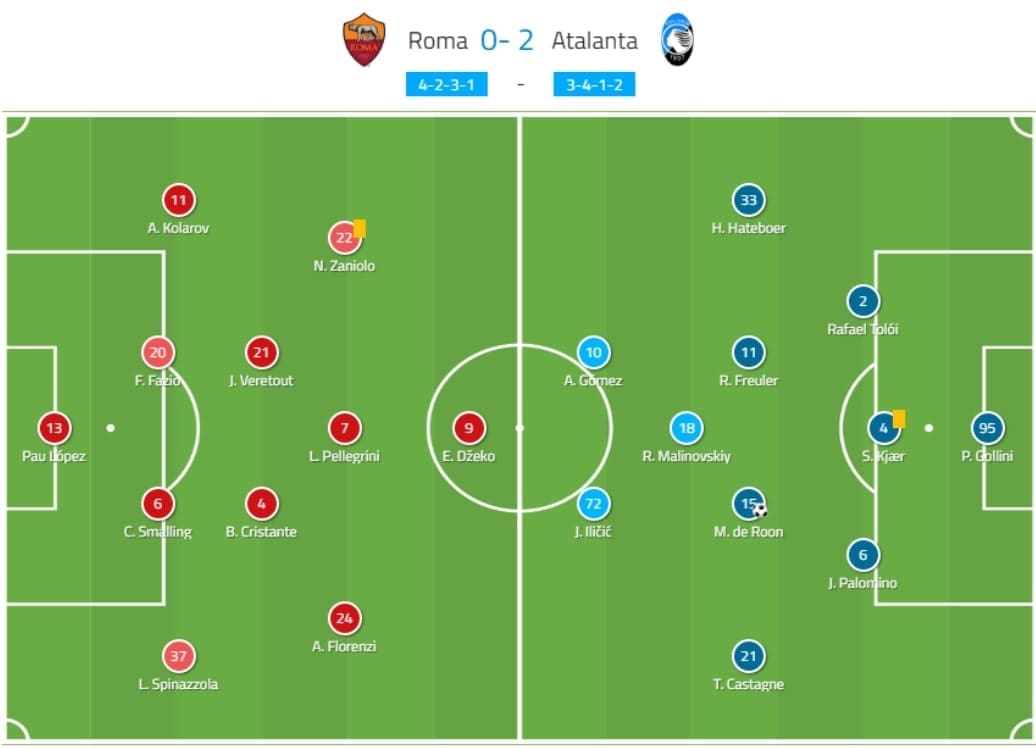
Although there were guesses they would play in a back-three from kick-off, Roma started in a 4-2-3-1 shape. There were some rotations in this game and Justin Kluivert and Henrikh Mkhitaryan were on the bench. Leonardo Spinazzola started as a right-back and skipper Alessandro Florenzi pushed to the right-wing. Gianluca Mancini was suspended so Manchester United loanee Chris Smalling partnered Federico Fazio at the back. Nicolò Zaniolo won his place back and played as a left-winger. However, Roma shifted to a back-three in the first half.
Atalanta started in a 3-4-1-2 formation. Gian Gasperini also tried other players who did not play in the previous fixture. There’s the return of their key man Papu Gómez, and the 31-year-old partnered with Joseph Iličić. Remo Freuler started instead of Mario Pašalić. Jóse Palomino was the only man who started in two successive games since Simon Kjær and Rafael Tolói replaced Berat Djimsiti Andrea Masiello at the backline.
Atalanta’s high press
Atalanta pressed high in this match. Before we investigate the pressing plays from Atalanta, we should take a look at the build-up plays of Roma in this analysis. Fonseca’s team build-up with their centre-backs and the pair of pivots, just as in the previous games. They want these four players to maintain a box shape to create a numerical superiority against the opposition. The centre-backs formed the first line and the pivots formed another line. This approach usually helped them to relieve pressure from opposition striker(s) and progress the ball upfield. Meanwhile, their full-backs’ positioning depended on whether the Roma players could break the press or not.
In order to counter the approach of Roma, Atalanta pressed high with a man-orientated system. They pressed intensely and closed off Roma players quickly to reduce time and space for the home players to make decisions. This disrupted Roma’s build-up since the home team could not break the lines in central areas. It forced Roma to play the ball wide, or goalkeeper Pau López to play long to try reaching Edin Džeko. Atalanta were well prepared for both solutions of Roma, therefore hardly could Roma build-up or create chances through open plays in the first half.
The following image shows the press of Roma. Roma players Smalling, Fazio, Bryan Cristante and Jordan Veretout formed the box to build the play up. However, all these four players were marked. Smalling could not pass vertically to break the press and his body orientation left him only one option: return the ball to López. The Spaniard then played long, but Džeko lost the aerial battle as Kjær headed the ball away. This approach kept Roma far from goal and the home team did not record any shot in the first 15 minutes.
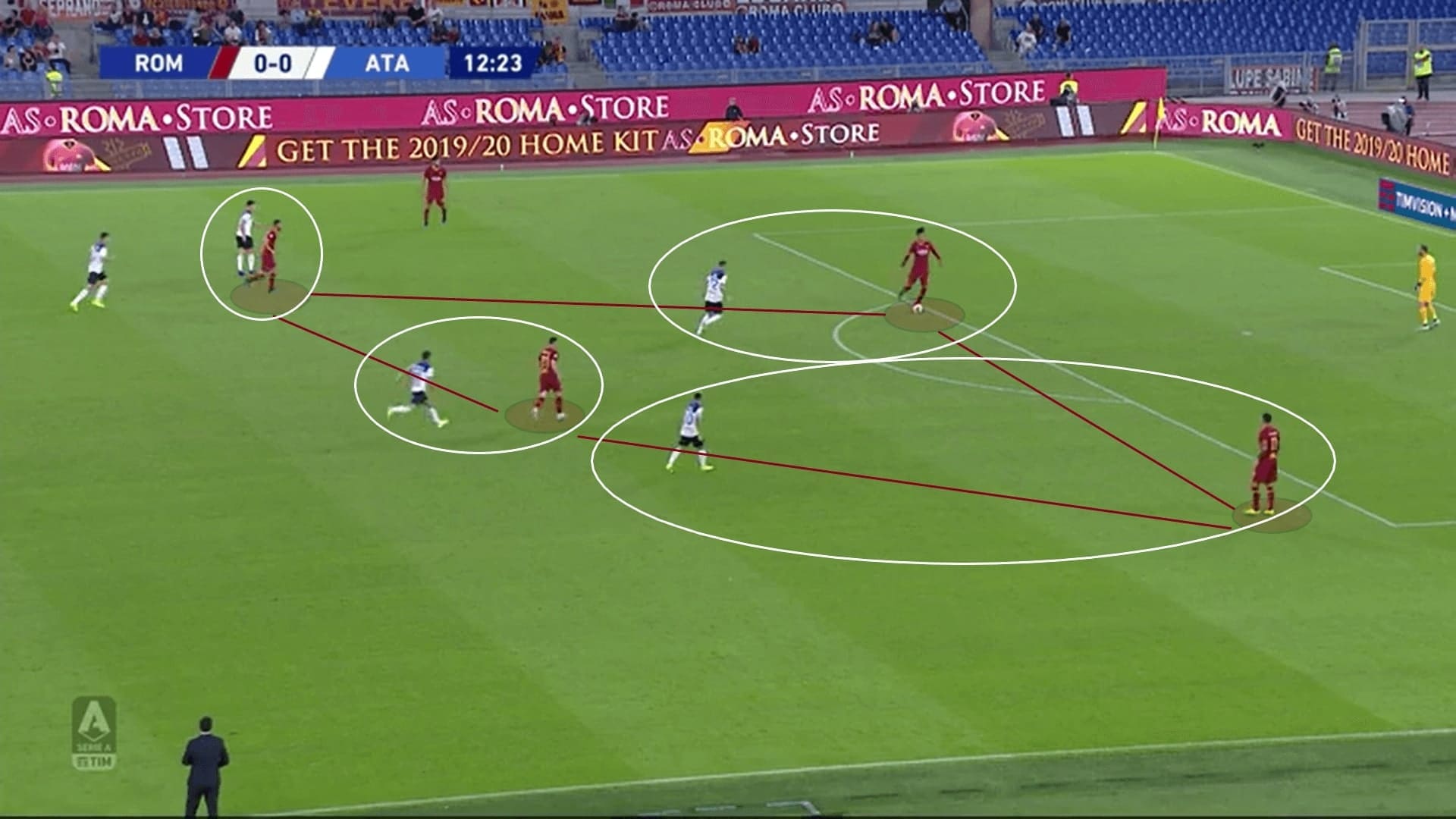
After Roma switched to a back three, things did not change completely. The build-up consisted of five players and Fonseca’s team still wanted to play out from the back with the extra man. However, Atalanta stuck to their approach which continued to work. In response to the change of Roma’s formation, they committed one more player in the press.
The below image illustrated how Atalanta performed their tactics. After switching to a back three, Roma build-up with a back-three and double-pivot. Fonseca wanted his team to build-up with an extra man, so to create a five vs four situation in the build-up. Therefore, Atalanta pressed with five players, it’s also the man-marking approach. All Roma players were marked. Gómez was pressing López and he covered the passing lanes towards Fazio at the same time. Again, it forced Roma to go long.
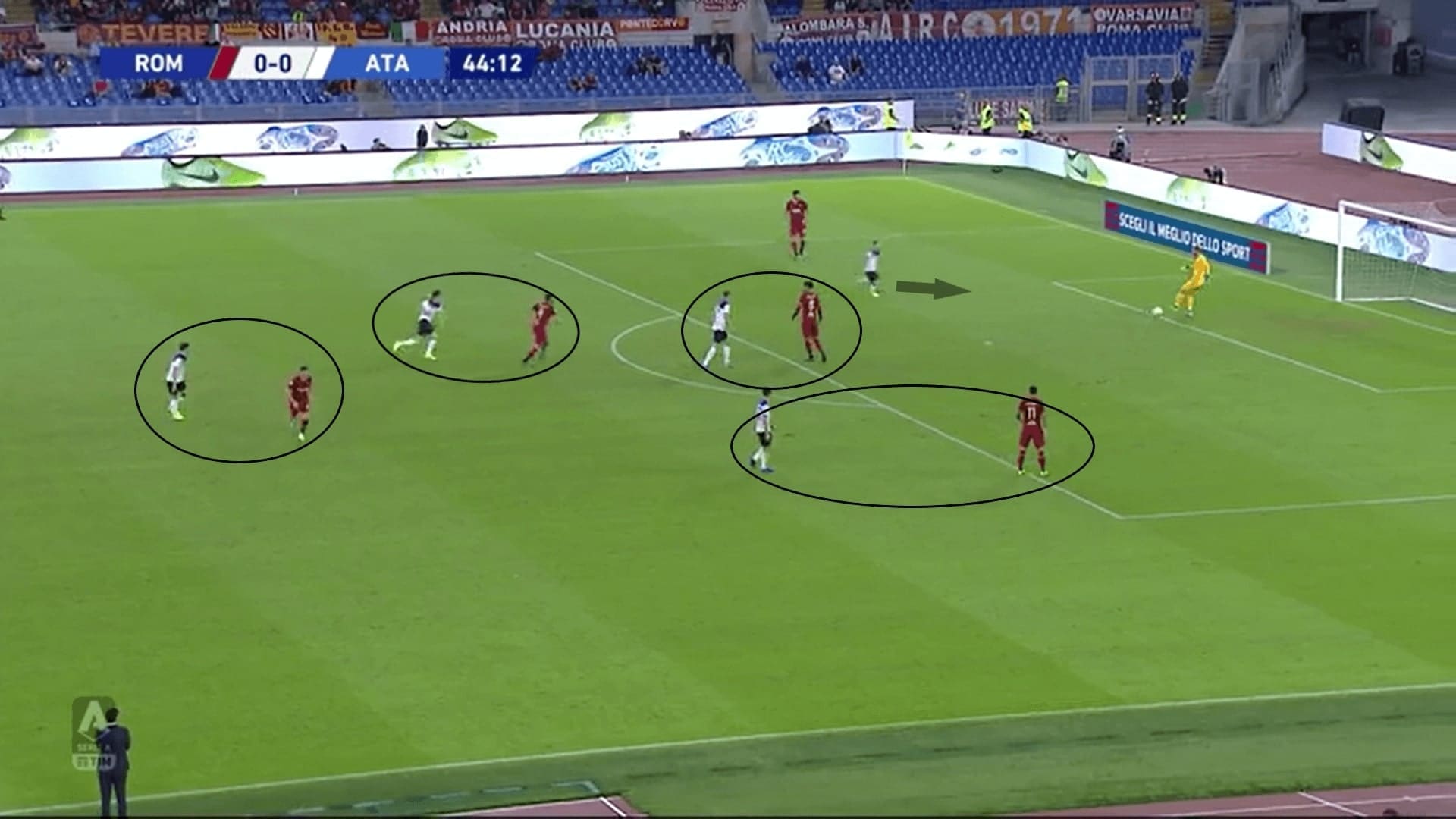
Spaces behind the Roma pivot
The lack of midfield protection and spaces between the lines were the biggest problems of Roma in this match. Atalanta used the space behind Italian pivot Cristante and created chances. Most of the time, Roma forwards tried to form the block high, but this required the pair of defensive midfielders to run a lot. The defensive midfielders should read the timing to cooperate with the block and trackback runs to cover space behind. Disappointingly, Cristante did not complete his defensive duties.
In the first case, Roma were still playing with a back-four. There were three red shirts compressing spaces down the flank and Cristante was the one stepping up to assist the press. With three players in such a tight area, Roma should press intensely to win the ball back. However, Cristante was slow to close off Ruslan Malinovsky. The Ukrainian could play a one-touch pass without any pressure.
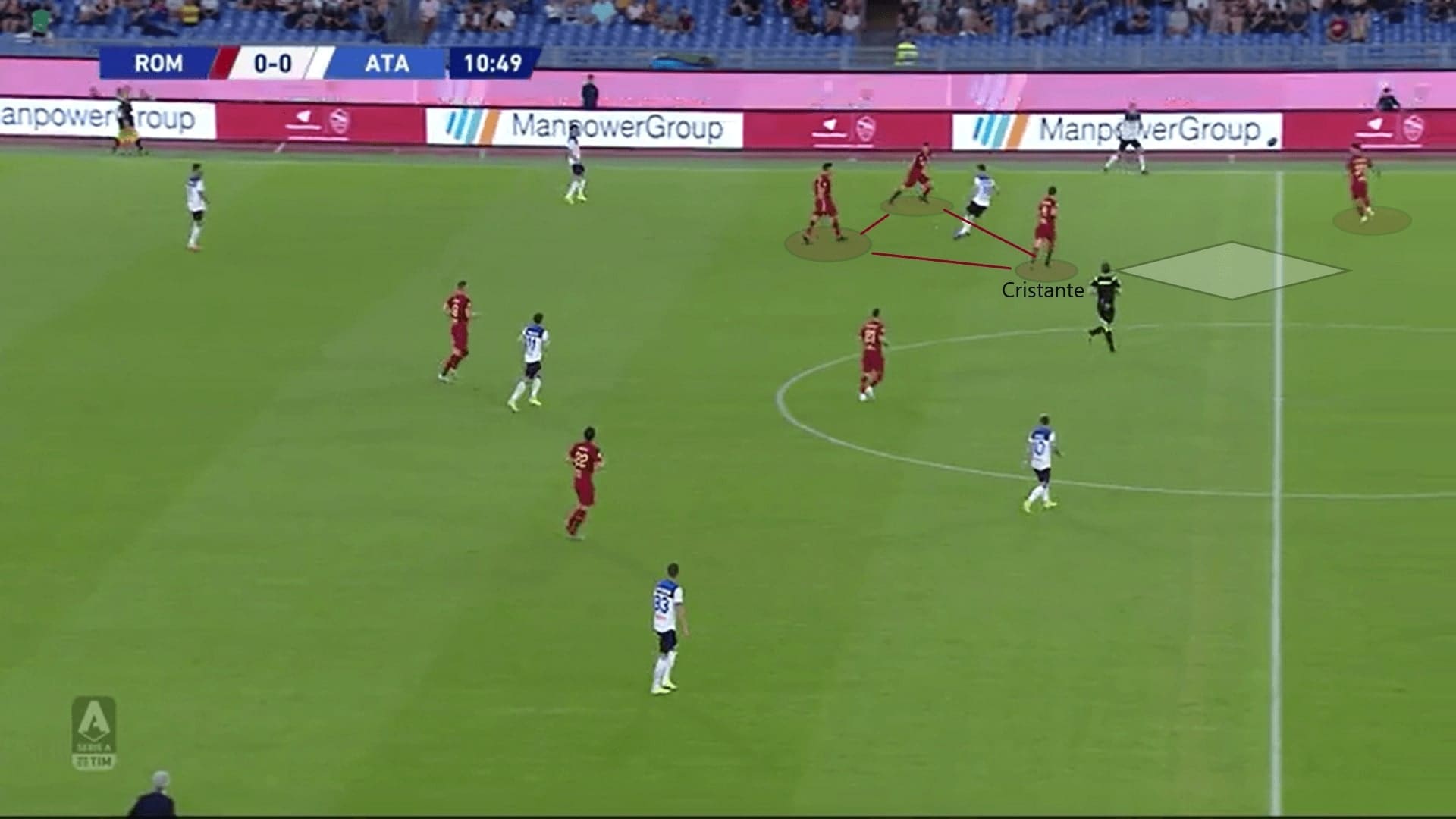
The second image shows the problem after Cristante stepped out but failed to win the ball back. Atalanta progressed the ball after the one-touch pass of Malinovsky and the Ukrainian received the ball, facing to the goal. Now, Roma backline was exposed. The gap between Fazio and Aleksandar Kolarov increased in instant and Iličić ran to exploit those space. This resulted in a shot from the Slovenian.
This example reflected the dilemma of Roma’s game plan with a back-four. Their defensive lines failed to cooperate with each other when defending, and their defensive midfielder failed to cover the spaces.
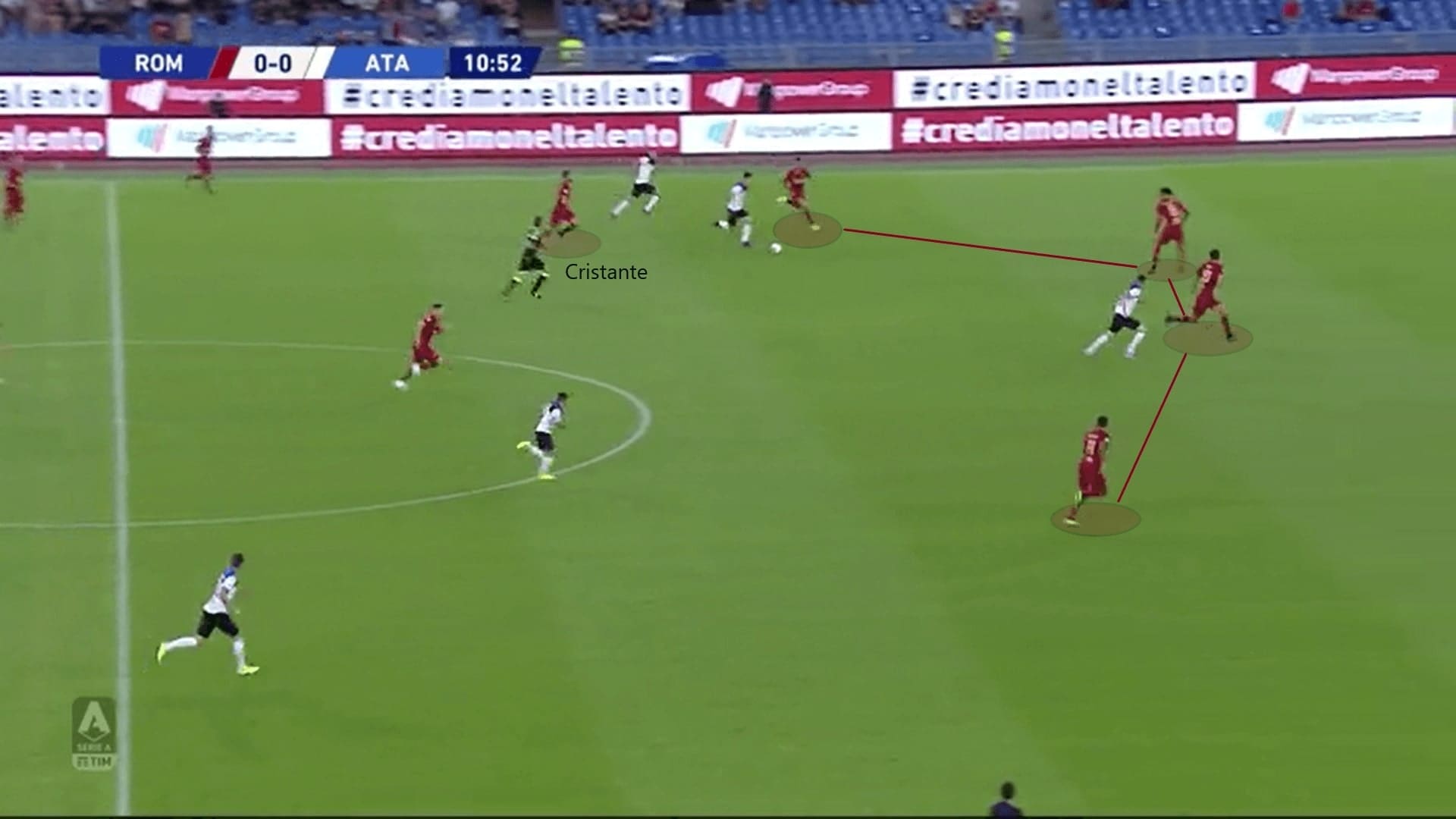
Switching to a back-three, Roma tried to tackle the above problem by allowing their centre backs to step up, preventing the central penetration from Atalanta behind Cristante. However, this did not work effectively.
We took the below image as an example to illustrate the situations. Roma formed two lines to defend. However, the distances between the lines were huge again. This was because the positioning of Roma centre backs, Smalling, Fazio and Kolarov was too deep that Roma backline was in a ‘V-shape’. Therefore, Atalanta front-three could exploit those space since Smalling failed to step up to clear the ball. Then, Iličić received the ball and turned, facing the goal and progressing the attack.
The above examples showed the common problems of Roma’s defence: spaces between the lines were huge. Also, the centre-backs did not react quickly to step up. They should stay compact vertically and maybe try to play the offside trap in the future. which could work well in this instance.
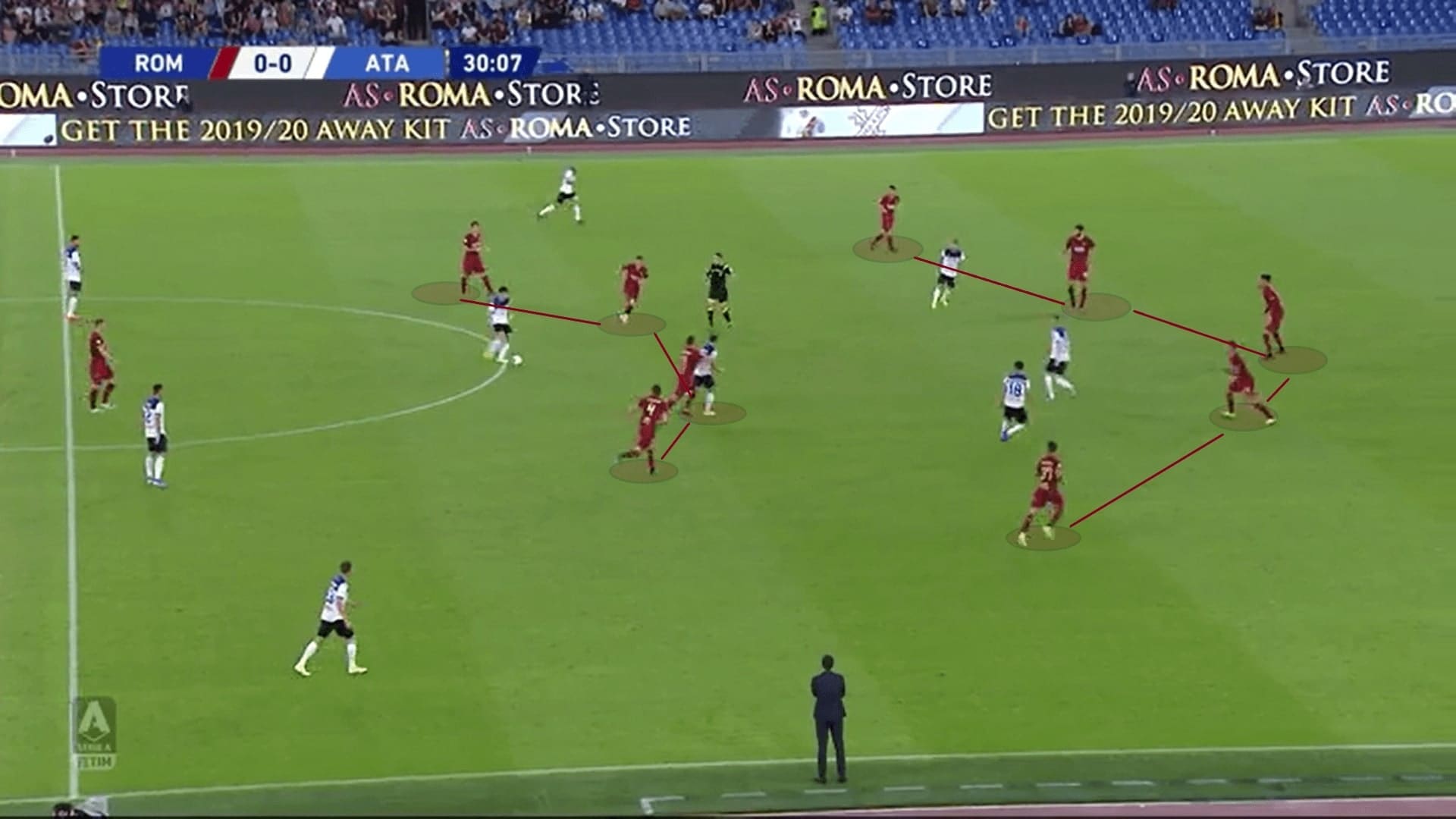
Roma’s failure in transitions
As mentioned, Roma failed to create chances through their build-up. And, what made the situation worse was their failure in transitions. They could not capitalise on transitions.
The following scene was an example. Roma won the ball back in the middle third, and the ball spread wide to Florenzi. But, the decisions of his teammates were strange. Zaniolo and Lorenzo Pellegrini both made forward runs instead of providing themselves as a short passing option. As a result, the Roma skipper could only play long to find Džeko, who is not a pacey player. The pass was easily read and intercepted. Nothing happened through transitions in the first half.
However, they did improve after the break but the youngster Zaniolo did not convert the golden chance after dribbling past the goalkeeper.
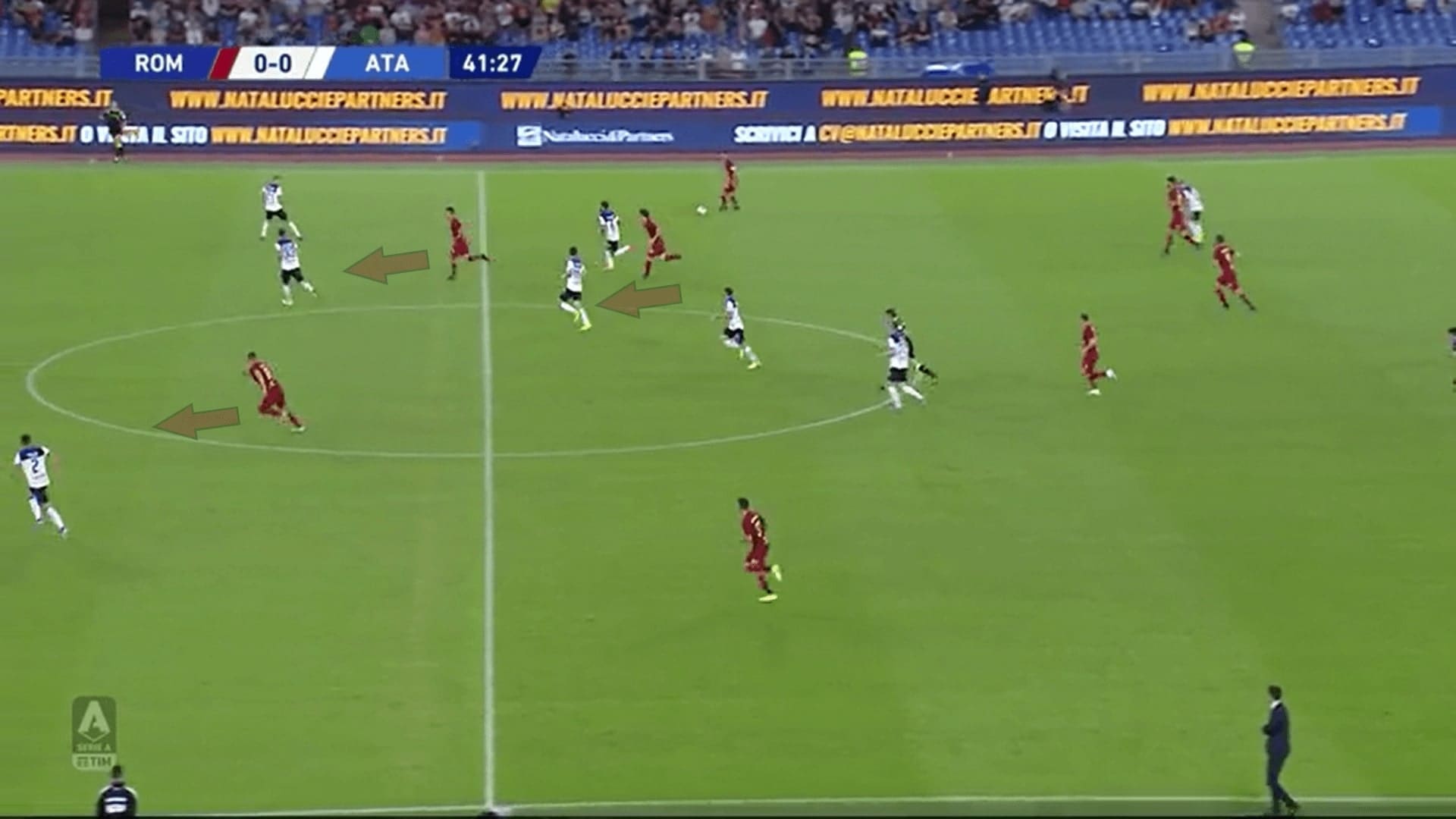
Slight improvement from Roma
After the break, Roma did slightly better in terms of their defensive shape. As mentioned, their spaces between the lines were enormous in the first half. They did not push the defensive line to cooperate with the block. Therefore, the home team stayed more compact vertically in the second half.
The below image was an example which shows the defensive line of Roma was good enough to reduce the threat from the opposition. There were two lines formed by the pivots and the back five. Although Atalanta could get behind the Veretout, Kolarov was quick enough to react and cleared the ball and prevented further progress of Roma attack.
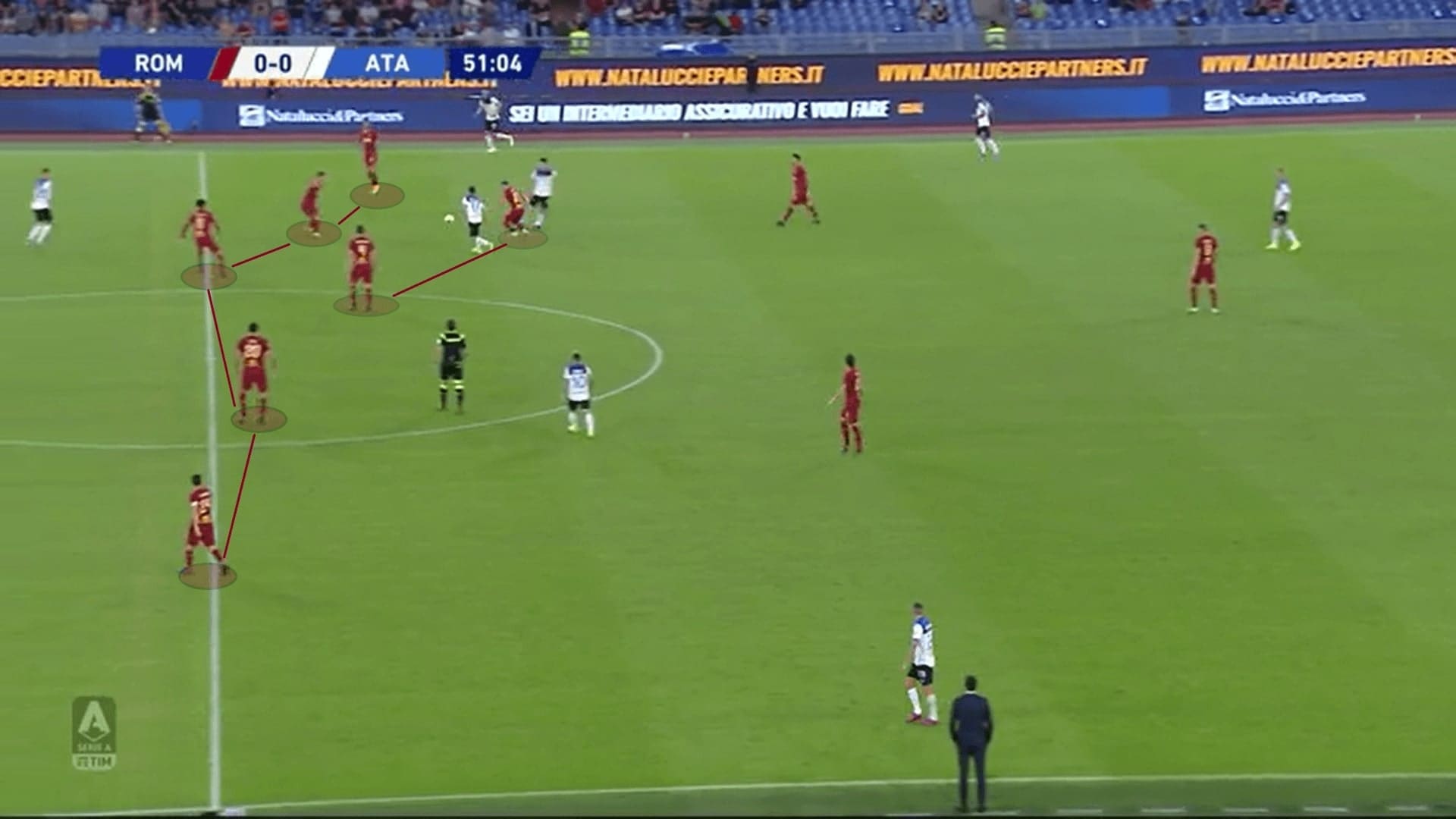
Where’s their competitiveness?
However, the real problem of Roma was their lack of competitiveness to win the game. We highlighted out their first conceded goal as this was the perfect example. Multiple errors and sloppiness costed this goal.
The first scene was the moment which Veretout gave away the ball very poorly in Roma’s own half. At that moment, we could observe the following: Colombia striker of Roma Duván Zapata was only marked by Smalling and the huge distance between Smalling and Juan Jesus. Veretout could have marked Freuler.
The Roma players could eliminate instant threat if they reacted better. For example, Florenzi could’ve made a tactical foul on Gómez and Jesus could have moved towards Smalling to reduce the distance between the centre backs and defend Zapata altogether. Veretout should mark Freuler to prevent the Swiss from even becoming a passing option.
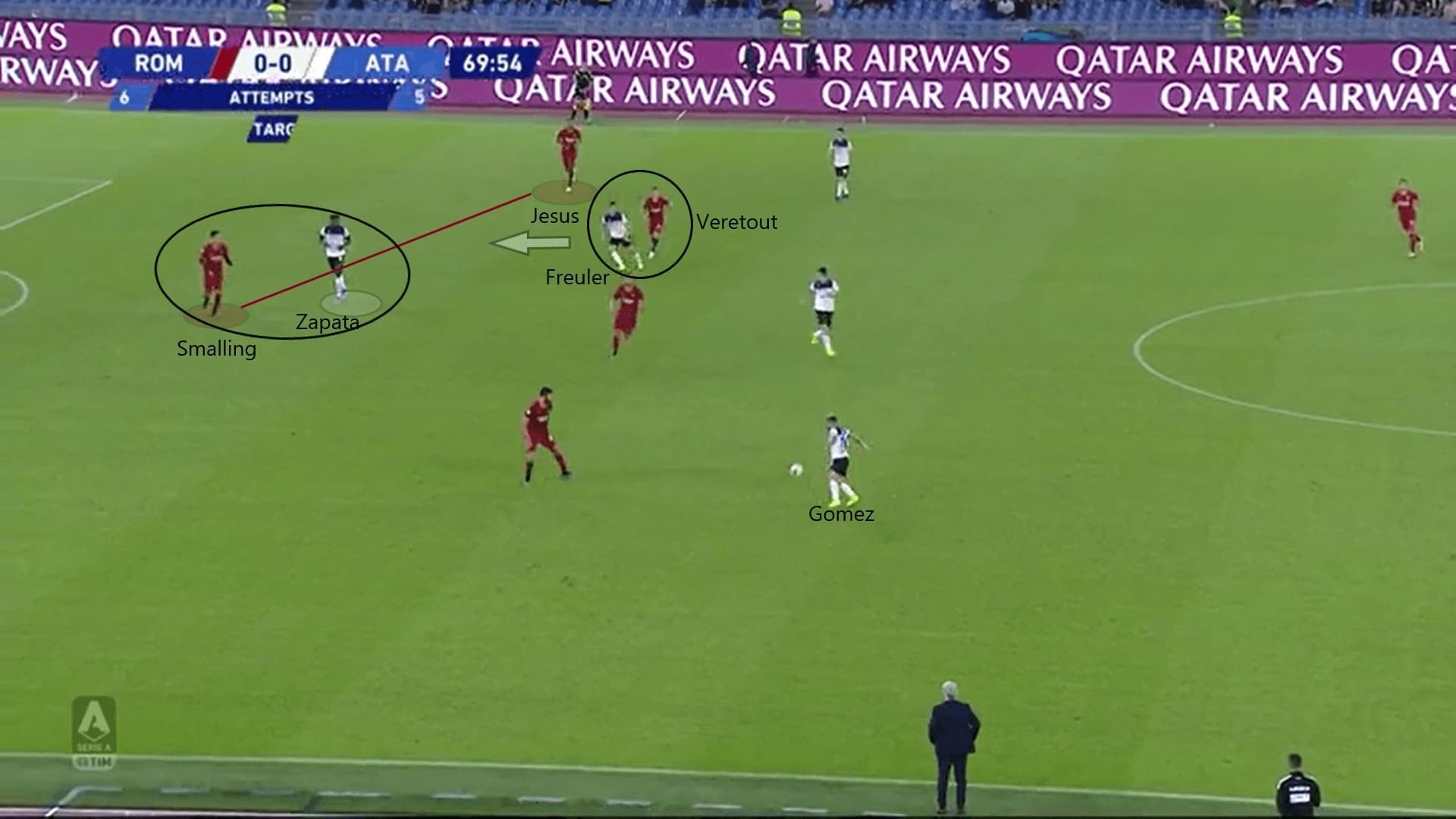
However, Roma players did none of the above. Veretout was sloppy and slow to react, he did not put pressure on Freuler so the Swiss received the pass from Gómez. If Jesus stayed centrally earlier, then he could have defended both players with Smalling, but he did not. This left the English in a one v two situation, and unsurprisingly the Colombian scored the first goal to break the deadlock.
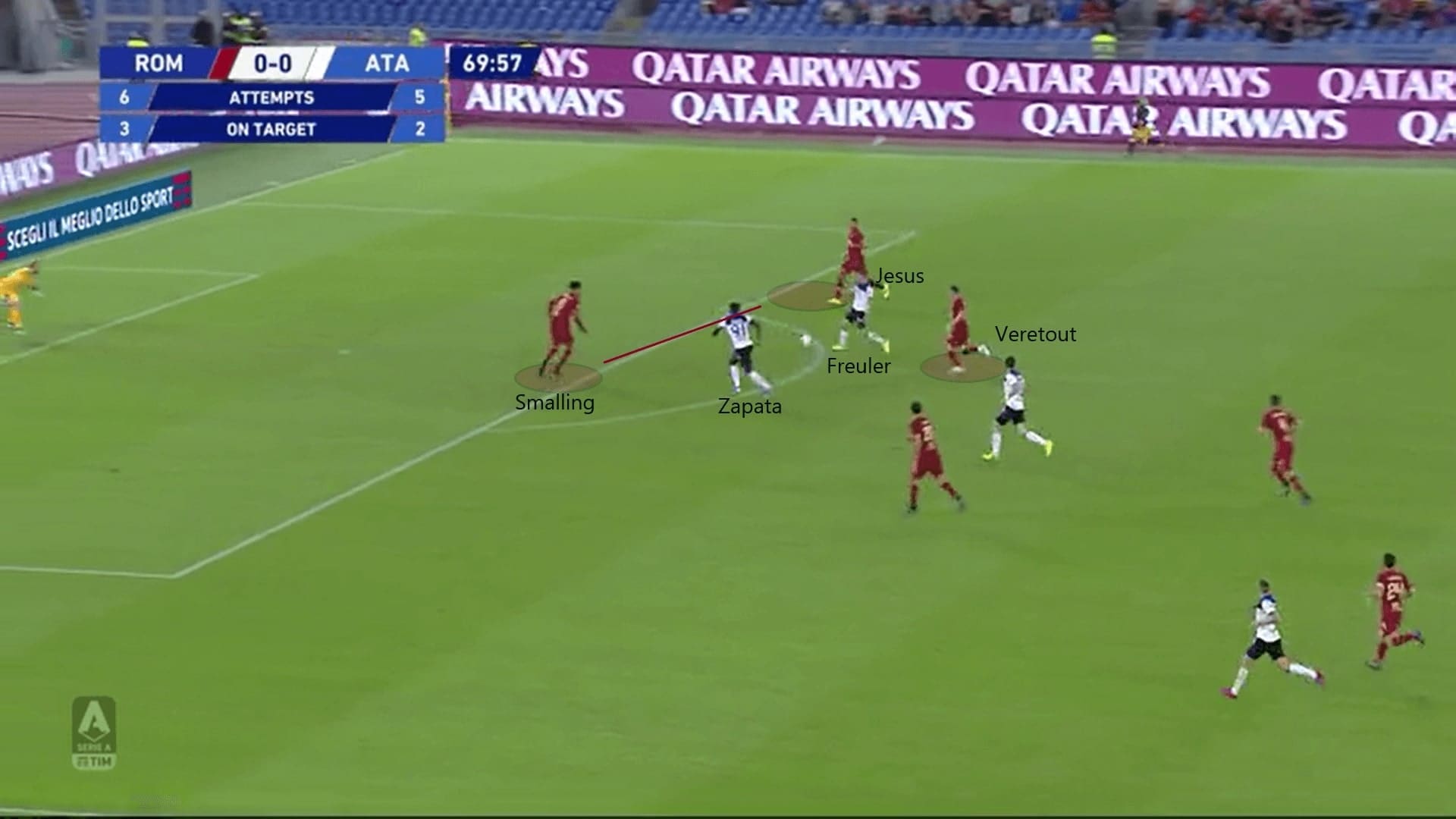
Final hope of Fonseca
The Portuguese manager Fonseca made his final change in the 76th minute. This was his last resort in the game, aiming for an equaliser. He chose Nikola Kalinić and placed him alongside with Džeko. Finally, there was a player to support Džeko. The Bosnian was isolated throughout the match.
Their biggest chance created thanks to this change was the below one. Roma played long to find Džeko, and the no.9 laid the ball off to Kalinić and created a chance. Fonseca valued the physical strength and height of both strikers, and Roma attempted to play long more in the final stages of the game. However, the passing quality was not good enough and that did not make significant changes.
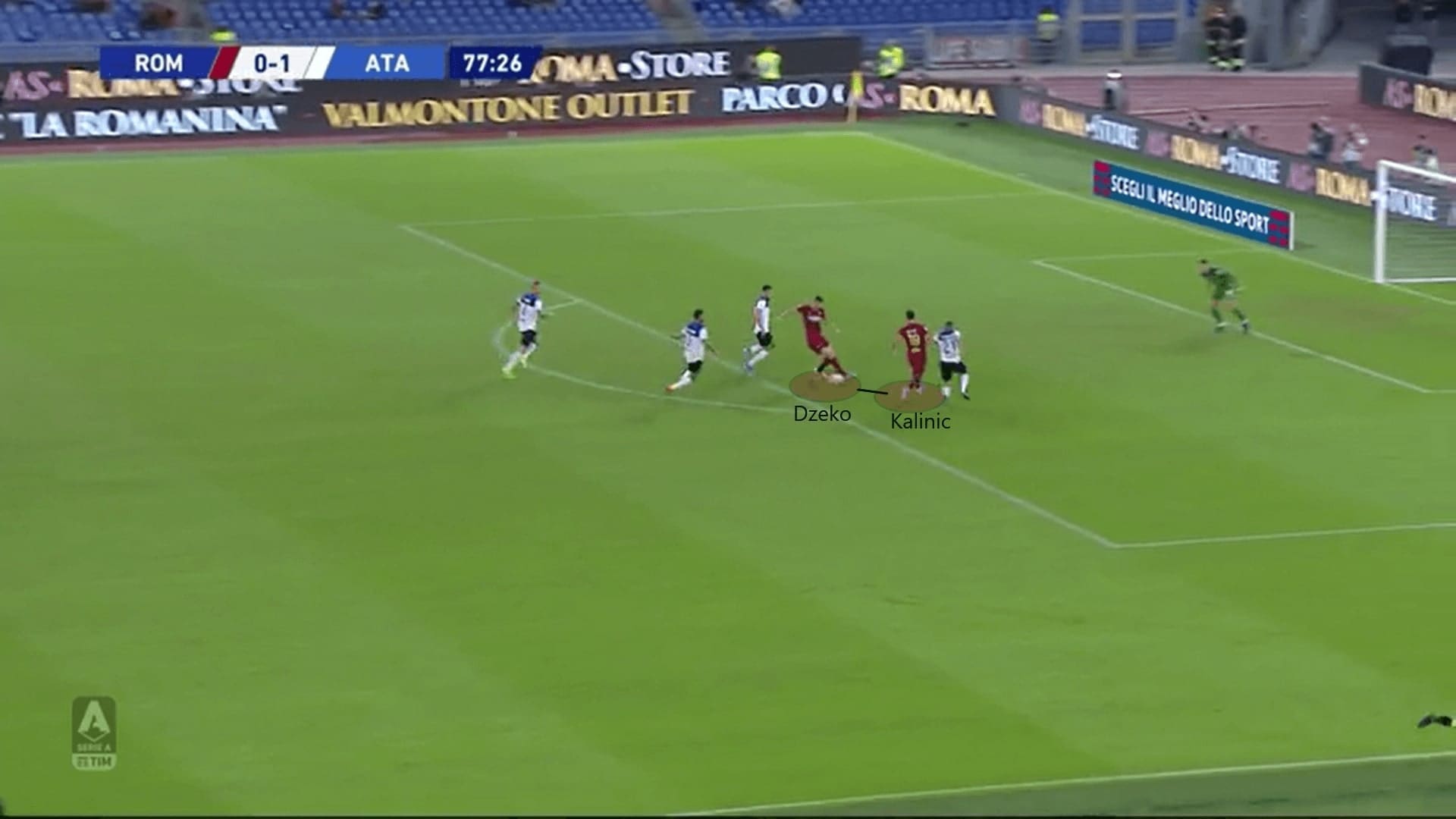
Conclusion
Roma did not have their best game, again. Tactically speaking, Fonseca and his team were improving and it takes time to see significant changes. However, the real disappointment was their lack of competitiveness and desire to win the game. They missed good chances like the open play miss by Zaniolo which recorded a 0.66 xG. It was also surprising to see Kluivert was kept on the bench for 90 minutes. The young Dutch played well in transition phases in the previous games. There’s still a long road for Fonseca and his team to go.
For Atalanta, it was nice to see them beating Roma. They were well prepared for the game and they converted their chances. Despite the very close difference in xG in this game (2.22 – 2.23), Atalanta were the better team.

If you love tactical analysis, then you’ll love the digital magazines from totalfootballanalysis.com – a guaranteed 100+ pages of pure tactical analysis covering topics from the Premier League, Serie A, La Liga, Bundesliga and many, many more. Buy your copy of the September issue for just ₤4.99 here





Comments